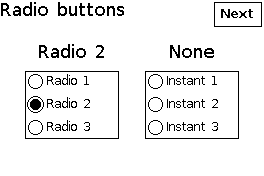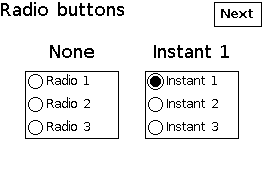Radio buttons¶
The radio buttons element is an input element and displays up to three mutually exclusive options.

Configure¶
Warning
Ensure the GUI library is included and initialised according to the configuration procedure.
RadioButtons myRadioButtons(&myGUI);
The constructor RadioButtons() creates a radio-button and sets the link to the GUI myGUI.
1 2 3 4 5 | |
dDefine() defines the radio-button with vector coordinates.
The required parameters are
-
The first line specifies the vector coordinates: top-left coordinates x-y then width and height in pixels;
-
The second line contains the item of the first option, here built with
setItem()with an index and a text; -
The third line contains the item of the second option, here built with
setItem()with an index and a text.
The optional parameters are
-
The fourth line contains the item of the third option, here built with
setItem()with an index and a text. The value can beitemEmptyto get access to the fifth line; -
The fifth line is optional: the size of the font, by default
fontSizeAutomaticfor automatic.
By default, the element is enabled according to the GUI setting and no option is selected.
As an alternative,
radioButtons myRadioButtons;
myRadioButtons.dStringDefine(10, 10, 80, 60,
"Radio 1",
"Radio 2",
"Radio 3",
fontSizeAutomatic);
The required parameters are
-
The first line specifies the vector coordinates: top-left coordinates x-y then width and height in pixels;
-
The second line contains the text of the first option, with index set to
0x0001; -
The third line contains the text of the second option, with index set to
0x0002.
The optional parameters are
-
The fourth line contains the text of the third option, with index set to
0x0003; -
The fifth line is optional: the size of the font, by default
fontSizeAutomaticfor automatic.
By default, the element is oriented horizontally, not enabled, and with no option selected.
Then,
myRadioButtons.setOption(optionVertical);
myRadioButtons.setState(stateEnabled);
myRadioButtons.setValue(0);
setOption() defines the orientation of the bar-graph:
-
optionHorizontalorfalsefor horizontal orientation; -
optionVerticalortruefor vertical orientation.
Note
Use literals instead of values for upward compatibility.
Default is false for horizontal orientation.
setState() defines whether touch is enabled for the element.
Select
-
stateDisabledorfalsefor touch disabled; -
stateEnabledortruefor touch enabled.
Note
Use literals instead of values for upward compatibility.
Default is false for touch disabled.
setValue() sets the initial selected option of the radio-buttons element:
-
0for no option selected; -
1,2or3for the first, second or third option selected.
Default is 0 for no option selected.
Use¶
myRadioButtons.draw();
bool result = myRadioButtons.check();
uint8_t value = myRadioButtons.getValue();
uint32_t index = myRadioButtons.getIndex();
draw() displays the check-box.
check() polls the touch controller and returns true is the button is pressed.
An optional parameter defines the mode of how the element is checked:
-
checkNormalfor normal check mode; -
checkInstantfor instant check mode; -
checkSpecialfor special check mode.
Default mode is normal check mode.
In normal check mode, the element requires the finger to be hold for a momenet and raises the event when the finger is released. Additionally, the element goes through a cinematic sequence.

Going from option 2 to 3: start, press, hold, release
In instant check mode, the element raises the event when the finger touches the element. No cinematic sequence is performed.

Going from option 1 to 2: start, press
In special check mode, the element raises the event when the finger is released from the element. A simplified cinematic sequence is performed.

Going from option 1 to 2: start, press, release
The technical note Optimise GUI speed provides more details on the cinematic sequences of each check mode.
getValue() gets the value of the selected option:
-
0for no option selected; -
1,2or3for the first, second or third option selected.
getIndex() returns the index of the selected option, set at dDefine().
Example¶
This is the core of the code from example GUI_Radio.ino.

void displayRadioButtons()
{
myScreen.setOrientation(myOrientation);
uint16_t x, y, dx, dy;
x = myScreen.screenSizeX();
y = myScreen.screenSizeY();
dx = x / 3;
dy = y / 4;
// myGUI.begin();
myGUI.delegate(false);
myGUI.dLabel(0, 0, x, dy, "Radio buttons", myColours.black, myColours.white, -1, 1, fontLarge);
Text myText1(&myGUI);
myText1.dDefine(dx * 0, dy, dx * 1, dy, 0, 0, fontLarge);
myText1.setOption(optionWithoutFrame);
myText1.draw("Normal");
Text myText2(&myGUI);
myText2.dDefine(dx * 1, dy, dx * 1, dy, 0, 0, fontLarge);
myText2.setOption(optionWithoutFrame);
myText2.draw("Instant");
Text myText3(&myGUI);
myText3.dDefine(dx * 2, dy, dx * 1, dy, 0, 0, fontLarge);
myText3.setOption(optionWithoutFrame);
myText3.draw("Special");
RadioButtons myRadioButtons1(&myGUI);
myRadioButtons1.dStringDefine(dx * 0, dy * 2, dx * 1, dy * 2, "Normal 1", "Normal 2", "Normal 3", fontMedium);
myRadioButtons1.setOption(optionVertical);
myRadioButtons1.setValue(0);
myRadioButtons1.setState(stateEnabled);
myRadioButtons1.draw();
RadioButtons myRadioButtons2(&myGUI);
myRadioButtons2.dStringDefine(dx * 1, dy * 2, dx * 1, dy * 2, "Instant 1", "Instant 2", "Instant 3", fontMedium);
myRadioButtons2.setOption(optionVertical);
myRadioButtons2.setValue(0);
myRadioButtons2.setState(stateEnabled);
myRadioButtons2.draw();
RadioButtons myRadioButtons3(&myGUI);
myRadioButtons3.dStringDefine(dx * 2, dy * 2, dx * 1, dy * 2, "Special 1", "Special 2", "Special 3", fontMedium);
myRadioButtons3.setOption(optionVertical);
myRadioButtons3.setValue(0);
myRadioButtons3.setState(stateEnabled);
myRadioButtons3.draw();
drawNext();
myScreen.flushFast();
myGUI.delegate(true);
while (!checkNext())
{
if (myRadioButtons1.check())
{
myText1.draw(formatString("Normal %i", myRadioButtons1.getValue()));
}
else if (myRadioButtons2.check(checkInstant))
{
myText2.draw(formatString("Instant %i", myRadioButtons2.getValue()));
}
else if (myRadioButtons3.check(checkSpecial))
{
myText3.draw(formatString("Special %i", myRadioButtons3.getValue()));
}
hV_HAL_delayMilliseconds(10);
}
}